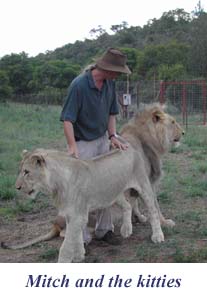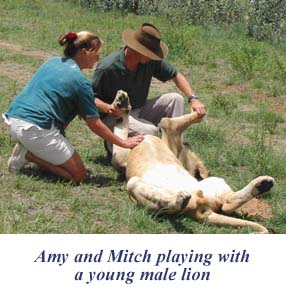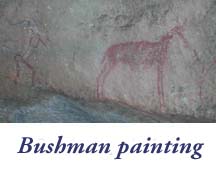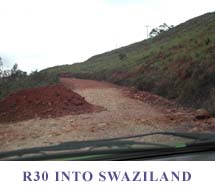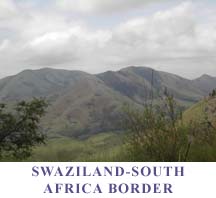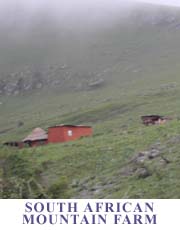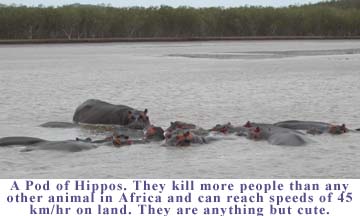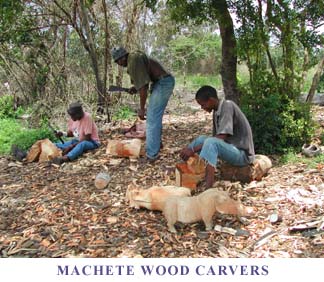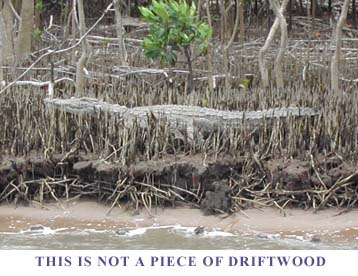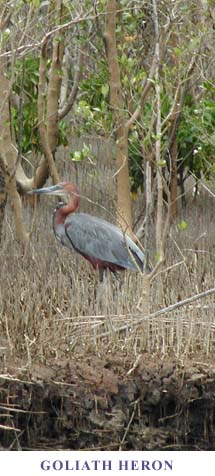
|

|
LINKS FOR THE YEAR 2002 |
| [JAN] [FEB] [MARCH] [APRIL] [MAY] [JUNE] [JULY] [AUG] [SEPT] [OCT] [NOV] [DEC] |
Archives [Intro] [2000] [2001] [2003] |
|
Log for the week of Sunday December 1, 2002 Richard's Bay, South Africa by APW We've been in Richard's bay almost ten days now and I still haven't found the town. "It doesn't exist" Phil keeps telling me, "You just don't get it." How can a place exist without a town? There are two malls that actually, I guess, define the town. One called the central business district and the other "the mall", separated by a cobweb of highways which do have triangular traffic warning signs, with wide mouthed hippopotamus's stenciled on them. Other than the monkeys and no squirrels in the trees, the signs are really the only things that make this different from Long Island New York. Signs in the pharmacies announce tests for malaria, HIV, or bilharzia. (There are all sorts of nasty parasitic diseases here. They can enter your body from any available orifice- if you get my drift.) HIV is also a big problem. The current president of South Africa is not recommending western treatments for AIDs sufferers. Nelson Mandela and Desmond Tutu are doing their best to try and educate people about how the disease is transmitted and the ways to prevent it. They are rolling a big stone uphill. Actually, the whole country seems to be rolling a big stone uphill. For those of you who were too busy watching "Northern Exposure" and "Bay Watch" on TV in the late eighties and early nineties, this turbulent time in South Africa resulted in the death of apartheid, or the end of the white dominated control over an entire country. It seems hard to believe, but it wasn't until 1994 that blacks could vote. Understandably, there is still much racial tension. People just don't seem happy. There isn't the singing, laughing and contentment that we saw in Tulear. With the exception of the yachties. We have met people here from the states, which believe they have reached yachtie nirvana. With the Rand at an all time low, the average rock turning cruiser can live like a king. Yet, the price structuring is slightly odd: Beer at a bar: $0.30 US Bottle of gin at liquor store: $3.25 US Dinner at fancy restaurant for 2: $14.00 US DVD: $36.00 US Paperback book: $10.00 US Day trip to game park: $12.00 US Car rental: $12.00 a day McDonalds Happy Meal: $1.10 Pepsi: non-existent Tie up at Tuli Gazi wall: free Tie up at Zululand Yacht club: ($2.00 a day 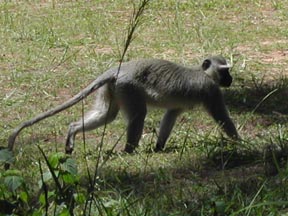
All of the available space around Richard's bay is being used for something- Eucalyptus trees are planted in rows, harvested like a crop. They are grown arrow straight, with leaf tufts and branches at the top, clear cut, stacked in rail cars or trucks then shipped off in the hold of big ships to other countries. Sugar cane is grown on the land not occupied by Eucalyptus. Where there is no farming, there are people. People live in compounds with high fences and razor wires curled like gift-wrap ribbon, festively garlanding the top. To enter a store not connected to the mall, you must ring a buzzer, wait a few minutes, then open the door, after a second buzzer sounds. Signs everywhere advertise security companies with "armed response". It is not lions, rhinos or elephants that people are trying to keep out, but other people. 
We made our first excursion to the Umfolozi-Hluhluwe game park, (the latter word is pronounced shishuli, don't ask me why), driving about an hour north of Richards Bay. On the way, we passed the modern day Zulu villages. Round stone and grass peaked huts, slowly being replaced with square brightly painted, tin roofed houses, most with electricity, few with any character. People everywhere. Children playing along the highway, sometimes selling bags of lychee fruit or golf balls. Women walking along the highway, sometimes with large heavy objects perched on their heads. Cattle graze along the edges of the roads, tied (sometimes) with rope. Men are either walking, or sitting on the guardrail or on old sofas dragged out for the purpose of watching the cars and trucks go by. 
The game parks are the best place for seeing the land as it was before man started to use it for farming. Umfolozi-Hluhluwe is a great place for viewing the "big five"- elephants, rhinos, buffalo, leopards and lions. We drove along the south road of Umfolozi, where Phil spotted an elephant performing his ablutions next to a riverbank. (South Africa is also the last place on the planet, besides a Jane Austin novel, where the word "ablutions" is used fairly regularly). We headed down a road to the right, hoping to get a clear shot with the Nikon of the elephant along the river. We failed to notice the eight tree trunks to the left, further up a hill. It wasn't until the tree trunks started to move that I realized they were actually two young bull elephants, scratching their behinds on a tree that was soon uprooted. Quicker than you would think was possible, with bodies the size of dump trucks; they walked Jar-jar Binks- style, toward our car. Phil slowly started to back up, not wanting to get stepped on as we were in their path, and not wanting to spin the tires, as our first inclination was "Holy car crushers, lets get the h--- outta here". Spinning tires and flying gravel, would not have been a good thing with these big guys. I am not sure Phil could drive the car that fast in reverse if they decided to charge. They stood in the road, looking at us, tusks up, ears fanning back and forth, gazing at the lime green car- puzzled. Obviously thinking we were the largest dung beetle they had ever seen. Eventually, they figured we were no real threat and lumbered off to the river. My Dad had told me that he really enjoyed the animals of Africa, on a visit a few years ago, (this from a guy that likes animals only for their nutritional value). He told me I would be amazed at how big they were. That was a colossal understatement. African bull elephants make their Indian counterparts look like cute pets. 
On Saturday we drove to Durban to visit our Dutch friends on "Red Oranda" and "Cornellia". Phil had done a repair job on Red's mainsail while we were in Reunion and they promised to take us out to in South Africa for dinner. It was payback time. We stayed at a schmancy hotel in Durban, "The Royal"; Chocolates on the pillows and doormen in attire best suited for Amsterdam in winter, all to the tune of about fifty dollars a night. We had a lovely dinner out and went the following morning to a "braai", a cookout at Alistair Campbell's house an hour south of Durban. Both he and Fred, the other ham radio guru were in attendance. We toured Alistair's radio room and got the scoop on why the weather fax situation is at best, unreliable. The government decided that weather faxes were unnecessary and were going to end them entirely, until a small band of protesters stepped in. It was suggested to transfer the responsibility over to the Navy, who reluctantly agreed to do it. Voice weather is broadcast on VHF, which is fine if you are along the coast, but if you are arriving here from anywhere else the VHF won't go out further than twenty or so miles. So the HF fax is important. 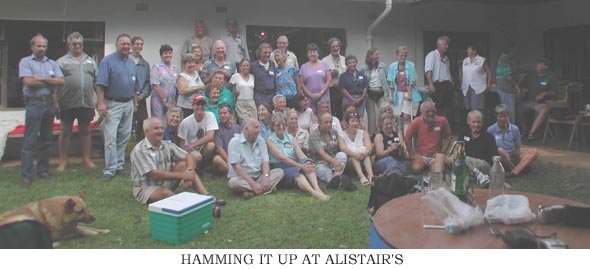
While walking along the docks in Durban we saw one boat stripped of all deck gear, wife with battered face and husband in the hospital, all suffered the ill effects of being too near the mighty Agulhas just days after us. They did not have the right weather information. 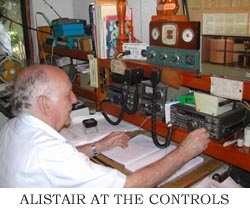
Well I could go on and on about cruiser gossip, politics, weather and other musings- but the other reason we went to Durban was to pick up my sister at the airport. She is right here, right now, so no one has to suffer through any more of my drivel. APW 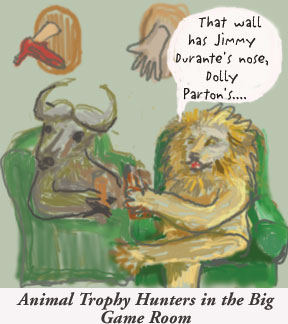 |
|
Log for the week of December 8, 2002, Richard's Bay, SA by PS I had hoped to get Amy's sister to do the log this week, as guest writer, but she was a bit short on time. She says she will e-mail it, so I'll post it when she does. We spent Sunday night in Durban. Our mission on Monday, was to find a place to haul out Iwalani, in order to paint the bottom. The Zululand Yacht Club, at Richard's Bay, declined to haul us because we are wooden. They were afraid we might hog. For those of you not familiar with this nautical term, hogging is like having a weak back. The bow and stern of the boat are unable to resist the pull of gravity. I wasn't going to argue about whether Iwalani needed a chiropractor. Having just crossed three oceans didn't seem to make a difference to them. We drove around the waterfront of Durban looking for a travel lift or slipway. After passing many huge dry docks for ships, we found the only facility for small boats at Bluff Point. We spoke to the manager and booked a haul-out on Christmas Eve at 7AM. Our 2.2-meter draft restricted us to being hauled on the larger tides of the month. Next we were off to the airport to pick up Amy's sister, Whistle. While waiting to get into the parking lot, we had a bit of a scare. In front of us was a small contractor van. There were two men in the rear, one of whom was opening and closing the back door with a long wire. Once through the ticket gate, the van stopped. Seemingly out of no-where, a man (in traditional Muslim clothes) ran across the parking lot and jumped into the back of the van, the door of which was quickly shut with the long wire. He had no baggage of any kind. The van then hurried to the parking lot exit and left the airport. The license plate was covered over, so we couldn't get a plate number. Being the paranoid Americans that we are, we reported what we had seen to airport security. They took down what information we could give them, and promised to follow up the incident. Amy and I were looking around for unattended baggage and saw many potential "bombs." The only airport security we saw was an officer staring into the large tropical fish tank on display, which he did for about 20 minutes. This didn't instill confidence in us. We headed to the most remote part of the airport lobby, in the hopes that a terrorist wouldn't bomb a vacant area. Once Amy's sister arrived, we wasted no time in getting back to Richard's Bay. 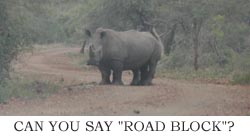
It's a shame that the world has come to this. Where we once practiced air raid drills during the Cold War, we now have to worry about dying without a moment's notice. People ask about the scariest part of our trip, expecting to hear tales about storms at sea. The threat on land is much greater. At least you can prepare for heavy weather. How can you prepare for a terrorist? The world has an enormous task ahead. Tuesday, I pestered Amy to write the log, despite the fact that Whistle was visiting. I got it posted and we went to Meerensee to get a Rhino Pass. For those of you planning to visit several game parks in South Africa, a Rhino Pass gets you into all the parks for a one time cost of $50 US per year. An individual visit cost $4 for the car and $4 for each person. If you go with 4 people in the car, two visits would pay for the pass. We booked an overnight stay at the Hilltop chalet in Hluhluwe from our rented cell phone. Our Qualcom cell phone, from the US, won't work here. Surprised? We stopped by the computer repair shop to see how Arnold was doing. The prognosis was not good. Seems the chip controlling the mouse was bad. Arnold would have to be sent back to Compaq or turned into "Arnoldstein" again. Amy decided to go the latter route. ("Arnoldstein" means removing his keyboard, using and external keyboard and an external USB mouse.) We arrived at Hluhluwe on Wednesday afternoon and immediately went hunting for lions. We got directions, from another cruiser, on where we might find them. No such luck. Seems the lions hadn't heard about where they were supposed hang out. We did see lots of other animals, which Whistle thoroughly enjoyed. The best part of our stay was the night drive with a park guide. We saw a leopard a mere 10 feet from our open Land Cruiser. I got a bit of a chill at the thought of him leaping in with us. Maybe it was just the cool night air. We also saw Genet cats, bush hogs and a hyena.  Thursday, we drove around Umfolozi looking for the elephants. With 300 of these giants roaming the park, we were sure we could find at least one. How could you possibly hide them all? The day wore on without finding a single one. It was about this time that I thought that a hot air balloon ride over the park would be an excellent idea. We never did see any elephants, but were rewarded with a great view of this cheetah. At this game park there are 300 giant elephants and only 40 cheetahs. Go figure. We headed back to Iwalani around sunset, where Whistle planned a tour for the remainder of her stay. After a rather late start on Friday, we headed inland. When I realized the distance we needed to cover to reach our accommodations in Tendele, I doubted we could get there before 10pm. I did my best to cover the distance safely, but my prediction of a late arrival was accurate. Not because of the distance, but the lack of signs and a good map. We had three paper maps and David DeLorme's Global explorer with GPS, which I happened to bring along. Despite the fact that we were often within 20 kilometers of the Royal Natal National Park, there wasn't a single sign pointing the way. By 7PM we were a bit hypoglycemic and seemed to be at our wits end. We traveled roads that were more like cow paths than roads to a National Park. Finally we decided that David had the best information. "In David we trust" Amy and I have been known to say and we followed the little green arrow on the laptop screen. That's about all we could see, as it was now dark and foggy. By 8pm we were entering the park and heading to our cabin. Thanks David! 
The Royal Natal Nation Park puts a whole different look to the South African landscape. It's a bit like Switzerland, with steep green slopes and misty peaks. Not anything I would have expected. We spent Saturday hiking to Policeman's Helmet. It was an enjoyable 3-hour hike that had us back to our cabin in time to avoid the afternoon thunderstorm. The high elevations are prone to stirring up the surrounding atmosphere. Sunday we stopped at the Tatham Art Museum in Pietermaritzburg. Admission was free, so I wasn't expecting much. Boy was I surprised. The exhibits ranged from classics like Picasso, Manet and Degas to modern Native South African works. It was the modern works that shed more light on the political upheaval in South Africa's recent history. Leave it to artists to paint a picture worth a thousand words. I knew there were violent times in South Africa's past, but now they were finally being put in perspective. This trip has opened my eyes to the world around me and South Africa is no exception. It's one thing to read stories in the newspaper or watch events on TV and another to be totally surrounded by them. That's all for this week. When Whistle's log arrives I'll post it. I'm interested to see what her perspectives are on South Africa. PS Log for the week of December 15, 2002 somewhere in South Africa by APW My sister's visit was way too short. I barely had time to try on all her clothes let alone swipe them. She left with a much lighter load- minus a few shoes, pants, raw water pumps, light bulbs and magazines. It's funny how eagerly we devour the strangest things. The newspaper packing material from Hamilton Marine was uncrumpled and our eyes consumed it with delight. After seeing my sister off in Durban, Phil and I returned to the boat to install the parts she brought us and make our annual Christmas card. I was ready, after a few days back on the boat, to go on safari and do something different.
We headed out of Richards Bay passed the "blue gum tree" farms of Australian eucalyptus, passed coal mines, factories, power plants, jails and many small Zulu villages. Gradually, the eucalyptus trees were replaced by farms of pine. These tree farms disappeared all together, leaving nothing but the rolling hills and savanna grasslands one usually associates with Africa. 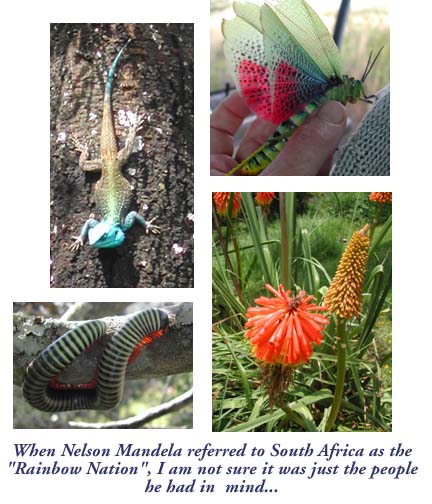
I was told by Kelcey to phone when we got within forty kilometers of their place so she could make arrangements for us to come in the last 17 kilometers by four-wheel drive vehicle. She had told me, when I made the initial arrangements, to make sure we arrived before dark because of the "attacks" in the area. She then asked me if we had insurance on our car, as there was a chance it could be "stripped." "Attacks?" "Stripped cars?" I carefully filed these phrases away for future perusal- storing them in the vaults of my brain away from Phil, until we were well on our way, or more to the point, over five hundred kilometers away from Iwalani. We arrived with plenty of daylight to spare. I casually mentioned to Phil what Kelcey had relayed to me and we decided to drive the final 17k in, despite the forewarnings of the road. Kelcey told us to call in back an hour to let her know we had made it. She wasn't going to be there, but would arrive the following morning- we would be taken care of by "the boys". Our car rental agreement said nothing about going on dirt roads and a dented underside is less obvious than missing windshield wipers, bumpers and car doors. We have grown rather fond of dung-beetle-green Basil and Phil drove very slowly, with me sometimes walking ahead to move oil pan denting boulders out of the way. An hour and ten minutes later, never once dinging the car's underside and quite thankful that it wasn't raining, ( we wouldn't have stood a chance of driving in if the road had been wet) we arrived at the camp. It was just as well we took our own car in. The four-wheel drive truck that would have picked us up had no brakes.  We were greeted by four good-looking fellows- Andre, a young volunteer from Germany with a British accent. Vickers- a modern day South African cowboy, complete with gun in holster; Clayton- the South African King of the one-liners, and the ringleader Mitch, a South African with all the dignity and inner strength of the lions he is trying to protect. Mitch has been struggling to remove lions destined for the "canned hunt" business and provide them with a quiet place to live, free from a gruesome final destiny. He explained to us that the "canned hunt" business is quite legal in South Africa and serves as a huge source of revenue for a very elite group of South Africans. A "canned hunt" is nothing more exotic than a very rich guy, carrying a big gun, shooting a drugged lion that is bred solely for the purpose of ending up in that "hunter's" trophy room. Because it is usually the head that ends up on the wall, the lion is shot first in the humerus to immobilize him, then in the chest for a slow death of exsanguination or suffocation. An average male lion head costs about $15,000 US, to grace some board room wall. This is very big money in South Africa. Not only are the private game parks involved, but people high up in the parks commission are in favor of it, as it provides good money and a way of dealing with the surplus animals at some of the game parks. Endangered animals are also taken illegally from the game parks and used in the "canned hunt" business. It was one such case that Mitch had been called in to testify. As a result, everyone was kind of on edge while we were there, because his testimony and evidence cut into the income of a lot of people. Unfortunately, for the animal's destined to become trophies, people who are trying to get rid of "canned hunts" somehow become less vocal as time goes by, from threats, or from just giving up. Some advocates have even turned out to be heavily involved in the business themselves. After spending a weekend at Enkosini, I can say that this is a legitimate non-profit agency struggling to put an end to a gruesome business that should not exist. But as long as people think the display of animal body parts is attractive, the business will continue either legally as it does now, or illegally through bribes and underground movement of animals. It all goes back to the laws of supply and demand. As long as there is a demand, there will always be a supply. The people at Enkosini do not drive a fancy car and the lion's are well cared for. The lions are implanted with a "Norplant" like birth control chip, so they don't breed. Their enclosure is several acres of wire fencing, supplemented with electric fencing and a sophisticated alarm system that happened to go off while we were there. The main disease concerns are not FIV, Felv, panleukopenia or rabies, but TB from the whole calf fetus's they are fed from the local abattoir. Enkosini funds go to protect the animals, not to pad the pockets of some person sitting in an office in New York. Eventually, they will have six eco-friendly chalets where people can come and stay far from civilization, amongst animals that have been removed from the canned hunt business. Some of the chalets should be open by February of 2003. That evening, we were treated to a traditional South African meal- a slow brewed stew of chicken, onion, spices, potatoes and cabbage, cooked in a cast iron cauldron over a wood fire. It was delicious and we didn't have to do the dishes. The next day we walked to a place where San people, otherwise known as bushmen, painted a scene depicting a small hunt. These paintings are thought to be visions of the "medicine man". The last "bushman" was seen almost one hundred years ago, near Royal Natal Park. Afterwards, we went for a hot hike to a stunning waterfall on the property, bushwhacking part of the way down and then back up a steep rock strewn slope. Our doughboy, pan au chocolat, cruiser bodies were screaming for mercy the whole way- we thought the walk with my sister was a hike! We still hadn't met the elusive Kelcey, the American financial analyst who came as a tourist and after falling in love with the lions, remained to help with Enkosini. She had been fielding reporter's questions in Johannesburg during our visit. Eventually, we met her as we were leaving- travelling with a baby spotted genet that she is hand raising. Our safari will continue for a couple more days- but Iwalani is due to be hauled out on the 24th of December and we must arrive in Durban before then. For more information on Enkosini and how you can help protect lion's from "canned hunts" visit enkosini.com 
|
|
Log for the week of December 22, 2002 Durban South Africa by PS. This week the South African newspaper headlines read "Park Ranger killed by Elephant." Our encounter with elephants, at Umfolosi, took on a whole new dimension. The "dung beetle" rental car wouldn't have stood a chance. And we thought Australia was dangerous! Monday, we drove to Swaziland, following Amy's instructions, until the road practically petered out and a four-wheel drive would have been a better mode of transportation. "Are you sure this is the right road?" I asked. "I think so." She replied. Once again I knew we were on an "Amy Tour." We agreed to turn around and head back to the tarred road. After re-checking the highway sign, we tried once again. I had complete faith in "Basil", after having climbed the mountain to Enkosini but that road was only 17 kilometers. This time we had to cover 45 kilometers. There were washouts, cliff edges without guardrails, narrow spots we barely fit through, fog as thick as custard and no other cars- we saw only one other vehicle. The rented cell phone was not in range of any towers either. Finally, we saw a high, electrified fence. We thought we had reached the boundary of a game park. No, it was the Swaziland border. We came to a typical guardhouse and got our passports stamped out of South Africa. We passed through a sort of no-mans land and arrived at another guardhouse. Here we cleared into Swaziland and were asked if we could give two men a ride into town. They were officials of the border control, so it seemed safe enough. After clearing the back seat of our assorted junk, they squeezed themselves in. Our little "dung beetle" started to bulge. The town was once a base for an asbestos mine. The only signs of life were a few people standing around the "store" and kids hitting golf balls on the deserted golf course. The mine had long since been shut down. It was a bit spooky to see hundreds of empty pastel colored houses. The men were grateful for the ride that saved them their usual 5-kilometer walk. It seems that not many people use this border crossing. Can you say "Amy Tour?" We found the people in Swaziland happier than in Kwazulu-Natal. Smiling more and looking up from their newspapers and waving to us as we drove by, while they waited in covered bus stops. Mercedes buses were everywhere filled to capacity, but more spacious than the South African Toyota van counterparts. The road took a turn for the better and we discovered we were approaching the king's residence. No wonder. The countryside took on a more natural look. No rows of planted trees in sight. This was surely a different country. We decided to continue back into Kwazulu-Natal before the border crossing was closed at 10PM. Checking back in was a bit scary at night. Lots of big trucks, people milling around and poor lighting. We arrived back at the yacht club around 11PM without incident, but I wouldn't make it a routine to drive at night. Amy's crown had fallen off (her tooth crown not her headdress), so we made an appointment to get it fixed on Wednesday afternoon. I offered to put it back on with some silicone, but she refused. We later heard, from the dentist, that someone tried to reattach their crown with crazy glue and ended up gluing their cheek to the tooth. Ouch! We had yet to see any hippos, so we headed to St Lucia Wednesday morning. The park offers a boat tour that covers more area than private tours are allowed, so we opted for the park tour. We were not disappointed. There were dozens of hippos, along with eagles and the world's largest heron. On the drive back to the dentist, we decided to do some last minute Christmas shopping. We had seen some hand carved animals along the roadside and stopped to take a closer look. There were people with machetes chopping away under the shade of a tree. It was hard to believe how detailed someone can carve with such a tool. We bought several animals and felt much better supporting these "craftsmen under the trees" than some lacquer smelling tourist shop. We checked the weather with Fred and Alistair on Thursday, and things looked good for a Friday departure, except for the day of the week. I had decided that sailing along the South African coast would be an exception to my "Never sail on a Friday" rule. We had to go when the weather window looked good. After asking the people at the Zululand yacht club office for the procedure on checking out and being told to ask yachties on another boat, we floundered around for 4 hours jumping through all the official hoops. In South Africa, you must clear in and out of the country between ports. What a hassle. First you must get a "flight plan" and fill out two pages of questions like "What ports will you be visiting, when will you be there and for how long?" I felt like putting "Depends on the weather." Then you must visit immigration and have your passports checked and your "flight plan" stamped. Then you go to customs and they stamp your "flight plan". Then you have to get your "flight plan" to port control. All of which covers about 20 kilometers. We hear it's even worse in Durban. I can't wait. After returning "Dung Beetle Basil" to the airport, I arrived back at Iwalani around 5PM, just in time to catch the last of the high tide. I started the trusty Westerbeke and discovered that the alternator wasn't charging. What did I say about leaving on a Friday? Thanks to the error lights on the Lifeline regulator, we were able to diagnose the problem to a blown fuse in the voltage sensor line. After getting permission from Port Control to leave the harbour, we headed out. We motored out past the breakwaters steering by hand. If anyone was going to run Iwalani on the rocks it was going to be me, not some auto-pilot. This proved a mistake because when I finally turned it on "No Data" was on the display. "Why not?" I asked. Of course it couldn't tell me. Where's HAL when you need him. (From "2001 Space Odyssey") We got out our back-up, 30 year old, "Tilley" but because we were under sail and motor, she couldn't cope. First she steered east then she headed south. Back and forth we went. The vision of hand steering Iwalani 100 miles to Durban was not a pleasant one. Amy wasn't bothered, but I was. It may have been the motion of the sea giving me an upset stomach, I'm not sure, but I knew this "Friday" thing was getting serious. I removed the cover on the flux-gate compass, but didn't see anything amiss. I looked at the connections at the back of the display. All seemed in order. I began removing the connections one at a time. When I removed the ground wire the display quit, so I decided to have a closer look. You may recall that I soldered every electrical connection on Iwalani. It seems not all soldered connections are the same. They may look OK but... After closer examination, I noticed a tiny bit of green corrosion. I decided to hand crimp the remaining part of the fitting to the wire. With my fingers crossed, I reconnected it. The autopilot was back on line. Whew! I hate Fridays. Ships were not launched on Fridays because the workers had their minds on the upcoming weekend off, not the work at hand. By 10AM on Saturday we were tied up the float dock in Durban. The Agulhas helped us cover the 100 miles of light north-easterly winds in less than 18 hours. Lets hope we can keep it working for us. Sunday morning we had visitors from Durban. One of my students from the Apprenticeshop, Greg Fredricks, was originally from Durban. Over the past few weeks I had left a phone message and sent some e-mail to Greg, not sure if it had gotten through. I guess it did. After catching up on what Greg had been doing and our trip sailing three quarters of the way around the world, Martin and Mo were kind enough to invite us to their home for Christmas Dinner. When it rains it pours. Fred (the SSB weather guru) said he and his wife Eva would be visiting us on Sunday morning. In anticipation of their visit and to celebrate defeating the Friday evil spirits, I made some "Sticky Buns." I'm not sure if it was the buns or the freshly ground coffee, but they invited us to their home for Christmas Eve Dinner. We suddenly went from loners at sea, to the social butterflies of Durban. I only hope that someday we can extend such hospitality. Iwalani will be out of the water by Christmas Eve and back in on the 30th. If the weather co-operates, we will get the bottom painted by the 27th so we can visit some more game parks and pick up our Pepsi and "V" that's waiting for us back in Richards Bay. South Africa is Coke country, so we had to special order a few cases of the competition from Namibia. Our order came in the day after we left. We are still searching for grapefruit juice. Holiday greetings to all. PS Log for the week of December 29, 2002 by APW Durban South Africa "I told them months ago that we needed new lifting straps, but the owner said it was out of the budget so that's why I am quitting. I just can't handle his cheapness anymore... " This was from the yard manager that quit just days before Iwalani's haul out. "If the lifting straps aren't any good anymore, should we still get hauled out?" I asked, putting two and two together. "Uh..." he said back peddling fast, "It shouldn't be a problem." So with this in mind, Phil and I motored up the small river, away from the city center, to the area where most of the repair work is done on ships and yachts. We really had no other choice- this was the only yard we knew of that could, or would, haul us out. We had bare spots of wood on the hull, which were ripe for toredo chewing. "It's not really the lifting up that's a problem." Phil said. "If the straps break while the boat is still over the water, she just falls down uninjured. It's when the boat is being carried by the travel lift and is half way over the water and halfway over land- that's when I really sweat." Now this was not a mental picture I had ever conjured up in my doomsday imagination. When the picture formed in my neural templates of Iwalani crashing down, hitting the cement ledge, then toppling over backwards like an overturned turtle- my bladder reacted in kind and left me with a stress related UTI. Just what I needed living 14 feet up a ladder. The boat yard replacement manager looked like he still wasn't old enough to shave, but after pocketing his Nintendo game, he seemed keen on proving himself. We didn't have any trouble, despite my imagination. The weather also cooperated with gale force winds arriving four hours later than scheduled. It was only after we were out of the water and securely parked in the dirt, with eucalyptus logs spaced every four feet to shore us up, that the horror stories of other boats not making it out of the water as successfully began to surface. We had a delightful time spending Christmas Eve with Fred and Eva from Peri Peri radio. I am still not used to the Southern Hemisphere summer Christmas tradition of wiping the sweat from your brow, as you plow into enough food to last a two-week passage. Fred and Eva have many cats and dogs, which were wagging and winding their way around our dinner plates and feet, making me just a little wistful for a house full of activity. Christmas in Maine is usually spent around the balsam fir Christmas tree. A real tree, perfuming the entire house with its thick dark green fragrance- not the fako Walmart version. How can something smell like a color you ask? Only in New England can you smell the green of Vermont, or the orange, yellow and red colors of autumn. But the dark green smell of a balsam fir forest is like no other, and a small whiff of it comes into the house at Christmas, when the rest of the landscape lies frozen and colorless outside. Christmas morning Ben and Nathaniel are giving whoops of delight as they open their presents. The dogs lie next to the wood stoves chewing their Christmas rawhide, the cats rolling next to them content with their Christmas catnip. A gentle snow silently falls, carpeting the fields and woods beyond. Just enough for an afternoon cross country ski. Christmas bread rises in the oven... "Whoa" Pull that needle from the gramophone. My mother called and their Christmas was anything but bucolic. Dad got the stomach flu and became so dehydrated he had to be hospitalized. A blizzard arrived, knocking the power out and making driving hazardous. The car got a flat tire in the process of getting Dad to the hospital. My sister was up at three Christmas morning plowing the driveways. Then everyone taking care of my Dad got the flu... Our Christmas was spent lounging around a suburban Durban oasis- a pool landscaped with tree ferns, palms and brightly colored tropical flowers. We were invited to Christmas dinner by the parents of one of Phil's boatbuilding students. We had a blast. Except for the conversation about the trouble with monkeys breaking into houses- it seemed hard to believe we were in Africa. We did talk politics and South Africa's politics are perhaps the most interesting in the world. And with Zimbabwe just to the North and all the excitement going on there, these places all of a sudden took on new meaning. Before, they were only names that came out of the radio while listening to NPR. In fact, a few days ago a woman asked me if "the red men still live in teepees, like the Zulu here, who live in traditional huts." Now to be perfectly honest, we haven't seen too much traditional Zulu lifestyle, despite all our meandering around the countryside. Round Zulu huts with thatched roofs are scattered amongst the hills, but the people wear clothes fashioned from the pages of Teen magazine, not National Geographic. With one exception. Late one night, as we were driving back to Richards Bay, we did pass a guy walking along the road wearing a leopard skin loin cloth and carrying a spear. Phil never saw him and thinks I was dipping into the Lariam. Not true- we are on Doxycycline for malaria, so Lariam hallucinations can't exist. I think all the interesting stuff happens after dark, which is why everyone tells us not to go anywhere at night. 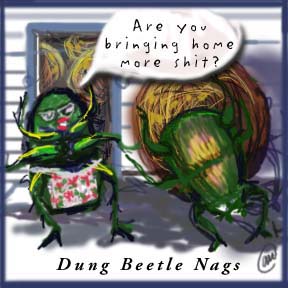
Phil, in record time, (with a little help from the gale force southwest winds, which helped to dry the bottom of the boat and even less help from me who ends up wearing more paint than gets put on the boat,) got us painted with our new RED Jotun bottom paint. Gone is Iwalani's green bottom. We are now a symphony of reds, maroons and pinks. We did not get the "toxic" Jotun that all the other yachties are going to great lengths to acquire here, as it is the last hold out for the skull and cross bones, tin saturated death mix. "Why would you want to use that stuff?" I asked one other yachtie. "Because I don't have to repaint the bottom of the boat for three years" he replied. "But I heard that people have died sanding this stuff off" I quipped. (I wasn't going to bring up the point that by using that toxic stuff he was basically killing off half the ocean with it, as I didn't want to be known as a clam-hugger.) "Yea, well" he said, "You do need to use a real respirator and get all suited up." Now maybe I am just thick headed, but it seems to me, once you put this paint on, there will always be the risk that at some level, parts of it will always be there. Who's going to know years from now, when this guy is long dead, that the bottom of his old boat has really bad stuff painted on it? Certainly not the guys in South Africa hired to do work on people's boats. At the very best, a worker here will put an old rag over his nose as he grinds off years of anti-fouling paint. I must admit, I had actually entertained the notion of hiring someone when we got to South Africa to take all the paint off- from the wretched International Micron CSC, to the precious, scarce, green Nautix.We would then just start all over with copper sheathing. But when we got here and I found out that the average worker gets paid 40 Rand a day, about 5$ US and would do the work with just a sock over his mouth, I just couldn't do it. We also have to keep our record of doing all the work on this boat ourselves, including boat equipment repairs and maintenance. The whole labor thing is something I am still trying to figure out too. I try and relate everything to the amount it takes to buy a Coke. The Coca-Cola currency, if you will. In the US, when we left, the minimum wage was $5, or so, an hour. If you bought a Coke at a gas station it was .75- let's call it a dollar. So the unskilled US worker could buy 5 Coke's an hour, or 40 Cokes a day. In South Africa, Coke is about 3 Rand a can. Lets call it thirty US cents, even though the dollar keeps dropping- so the average South African can only buy 13 or so, Cokes a day, vs. the US workers 40 Cokes. Is there something wrong with my math here? Or is there something wrong with this picture? On top of this, is the dreaded 14% VAT- so it's a wonder the South African can buy anything at all. But of all the African nations this is the most prosperous. What does the South African get for all that VAT money? Not much that I can see. There are few policemen, I have never seen a fireman and there is no welfare. When a tiny little waif comes up to us with one palm outstretched and the other hand rubbing their stomach, saying they are hungry- they really are. We have developed a new system called the peanut game show. In order for a beggar child to win cash he or she must answer three questions: What is the sum of 4+5? What is the capitol of South Africa? A real question, because I am still looking for the answer- It's either Pretoria or Johannesburg (my world Atlas was printed in 1993- it looks like they thought the whole South Africa thing was up in the air back then) ...and a simple letter recognition question. So far, everyone has ended up with the bag of peanut consolation prize and I don't have my answer for the capitol of South Africa. With all our travelling through the Indian Ocean, South Africa seems to be a bustling exporter. Ships are leaving ports, lower in the water line than when they arrived- (if that means anything). And yet, there is this Coke thing. It really seems like this country should be right up in the wage ballpark with the rest of the top players- Europe, Australia the US. This country is loaded with gold, diamonds, trees, coal and lots of smart people- how can the Rand be so weak? I just don't get it. Maybe that's why I am a veterinarian and not an economist. This whole foreign aid thing had always been a mystery to me too. Other countries besides the US give aid, lots of it to other African nations. Are we cheapskates if we cut it off? I was told that Bush cut off foreign aid to Swaziland, because the Swazi-King wanted to buy a new jet. Kudo's to Bush if that's true. But does aid really get to the people? Or to where it is needed? Zimbabwe is just to the north of us. White people really are being ousted off their farms, there is no fuel and people are starving. However, war torn Mozambique, also just to our North, is starting to come around. I gather it's a great place to buy used AK47's for about $18.00 US, or go Scuba diving. We found out that the reason there is no Pepsi here- is because Pepsi somehow did something to offend someone, somewhere- and now Coke is king. Pepsi is imported from Namibia- which is why we drove to Richards Bay from Durban one last time, so Phil could pick up his Pepsi specially ordered in! 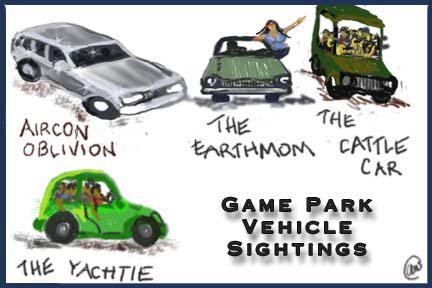
We also decided to spend one last night in the Umfolozi game park. I had wanted to camp but there was nothing available as this was the biggest vacation weekend of the year. So we had to settle for a night at Hilltop, which we had already visited when my sister was here. (The other thing I still want to do is a five-day hike and camping expedition through the wilderness area of Umfolozi. It costs about 1000 Rand and they supply the food and tents. See www.kznwildlife.com or phone 27-33-845-1000) Umfolozi/Hluhluwe is the oldest game park in South Africa. Not as well known as Kruger, certainly not as big, but packed with plenty of animals. Unfortunately, over the Christmas break they are also packed with people. We saw the usual big five minus the cats- too hot for them as well as us. Being cat-less on the boat has its definite drawbacks. Stewart was the chief bug officer and with his blindness and frailty, I always thought he was shirking his duties. Now we are being over run with bugs and I see how wrong I was. When we were tied to the French boat in Reunion we noticed that it came alive with cockroaches at night. Now we seem to have a similar fate. The roach hotels only seem to provide them with a nourishing fodder. We are busy finding a lizard to serve as Chief Insect Officer. Any applications will be greatly accepted. This week I had a technological debacle, for no other reason than my magnetic personality, I guess, erasing the microcircuitry in all our electronic doodads. My computer Arnold is still really dead. Phil and I are convinced it is the power supply-, which has always given us a problem from day one, or the c-mos chip. So far, no one in South Africa has been able to fix it. That's ok, I can live with it- but some of Stew's writings were on it and I want to get them off of it somehow. (No, he didn't back up his stuff... ) In one day I also managed to erase the brain in the Epson printer and the Nikon "Coolpix" camera- again. This same thing happened when we went to New Zealand and we blamed it on the airport security. This appears not to be the case. How we are going to get it repaired (again) is anyone's guess. So, the bad thing about that is that there will be no new web pictures. Which is why you must suffer with my drawings and ramblings, when I know that people are really only interested in pictures... APW |
 Safari means "long journey", not guys driving around in land rovers loaded with big guns. We had spent all of our time so far at the Kwazulu-Natal Park system, and had enjoyed all of our visits, experiencing something different each time. I wanted to go to a private game park- where most foreign tourists visit, to see what they were all about. They are usually pretty expensive, so not really a typical cruiser destination. I had heard something about "canned hunts" and I wanted to know if they really existed. I was leery about staying at a private game park that actually participated in such hunts, so we decided to go (at the suggestion of one of our readers) to a lion reserve and animal rehabilitation center run by his daughter, Kelcey. Up until now, we had seen cheetah, spotted genets, and leopards, the only big cat left to see was the "King of Beasts". I phoned Kelcey and made arrangements to stay Friday and Saturday night at Enkosini.
Safari means "long journey", not guys driving around in land rovers loaded with big guns. We had spent all of our time so far at the Kwazulu-Natal Park system, and had enjoyed all of our visits, experiencing something different each time. I wanted to go to a private game park- where most foreign tourists visit, to see what they were all about. They are usually pretty expensive, so not really a typical cruiser destination. I had heard something about "canned hunts" and I wanted to know if they really existed. I was leery about staying at a private game park that actually participated in such hunts, so we decided to go (at the suggestion of one of our readers) to a lion reserve and animal rehabilitation center run by his daughter, Kelcey. Up until now, we had seen cheetah, spotted genets, and leopards, the only big cat left to see was the "King of Beasts". I phoned Kelcey and made arrangements to stay Friday and Saturday night at Enkosini. 